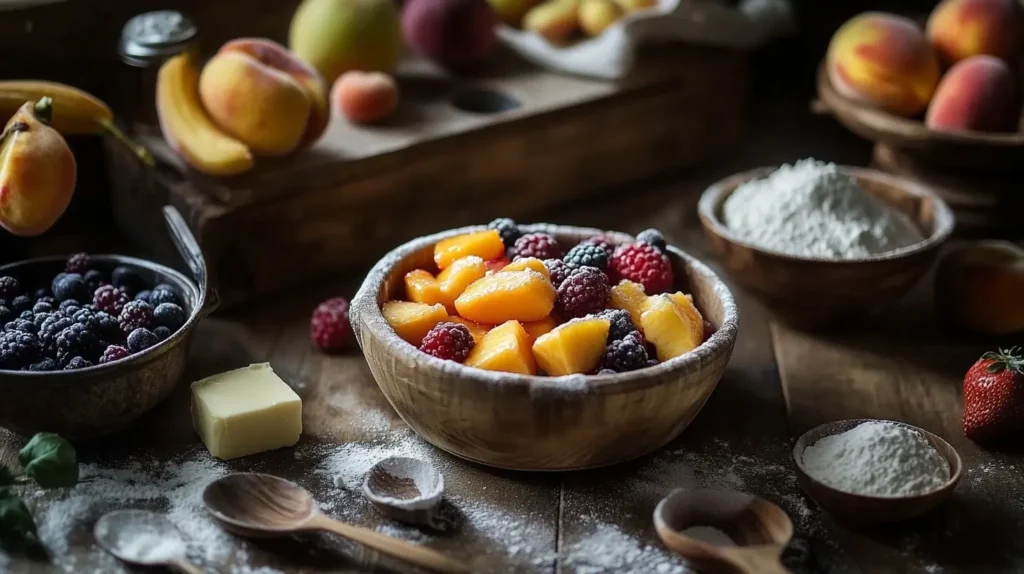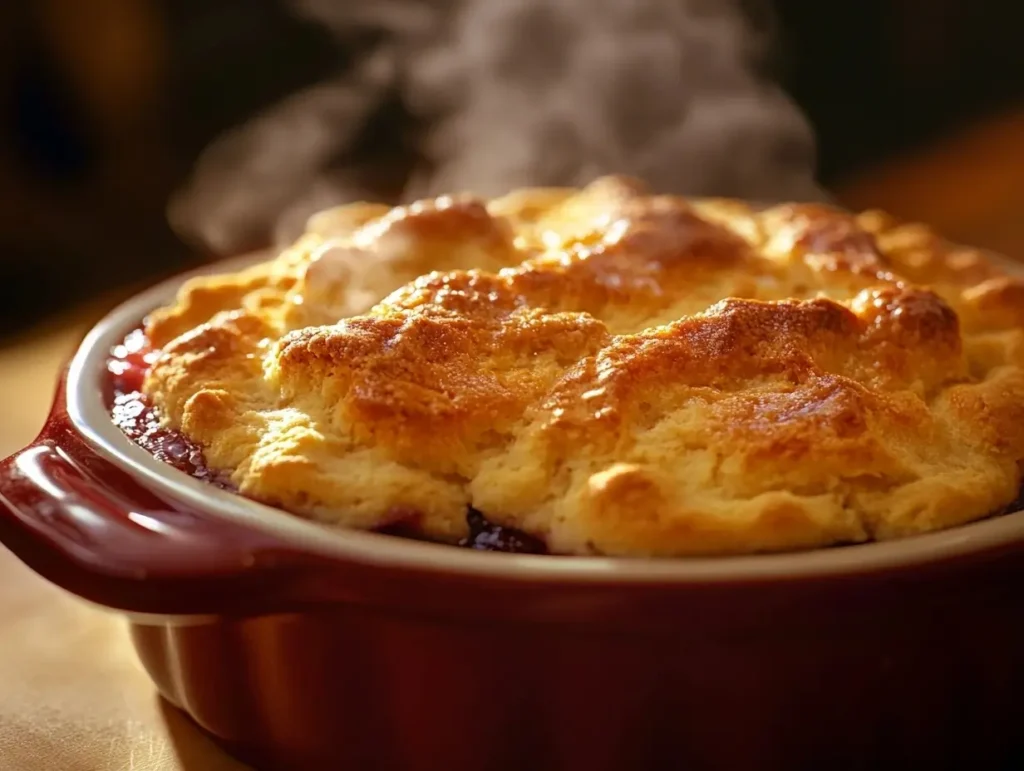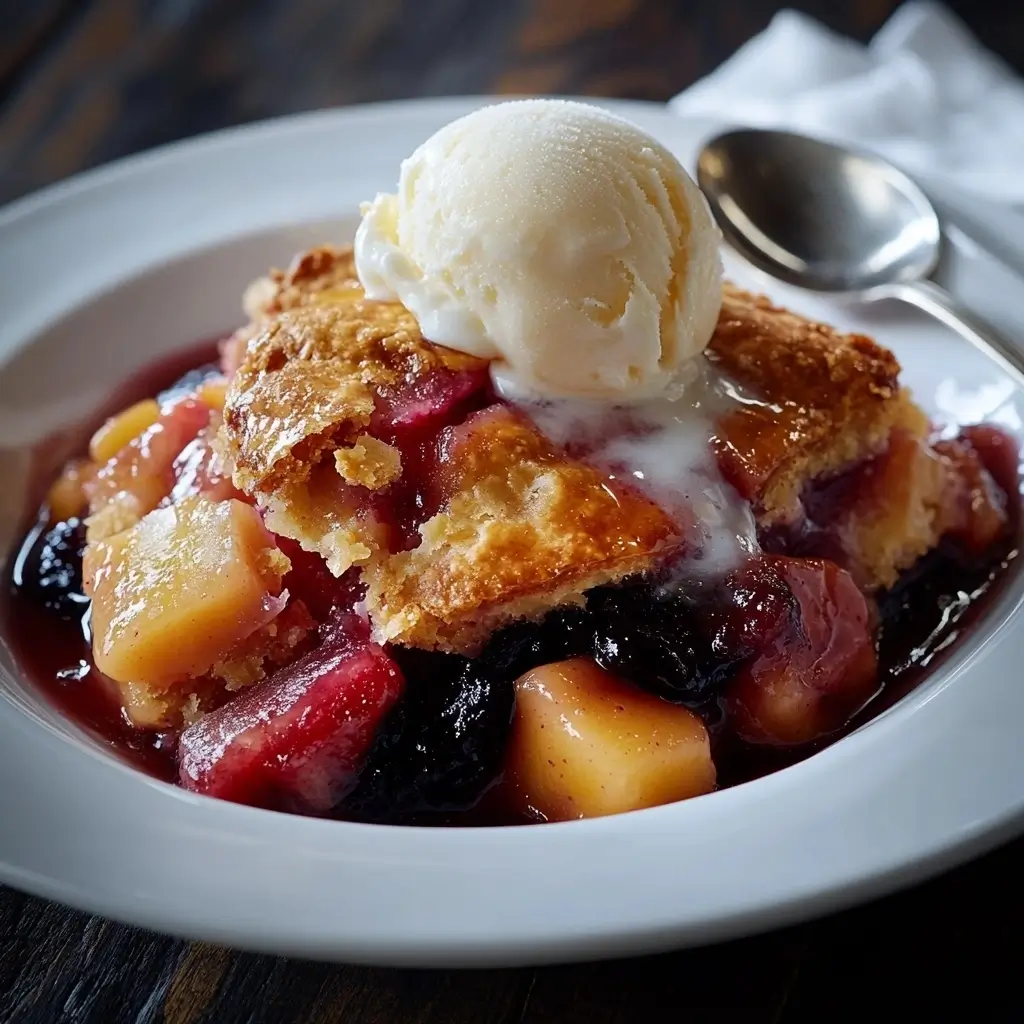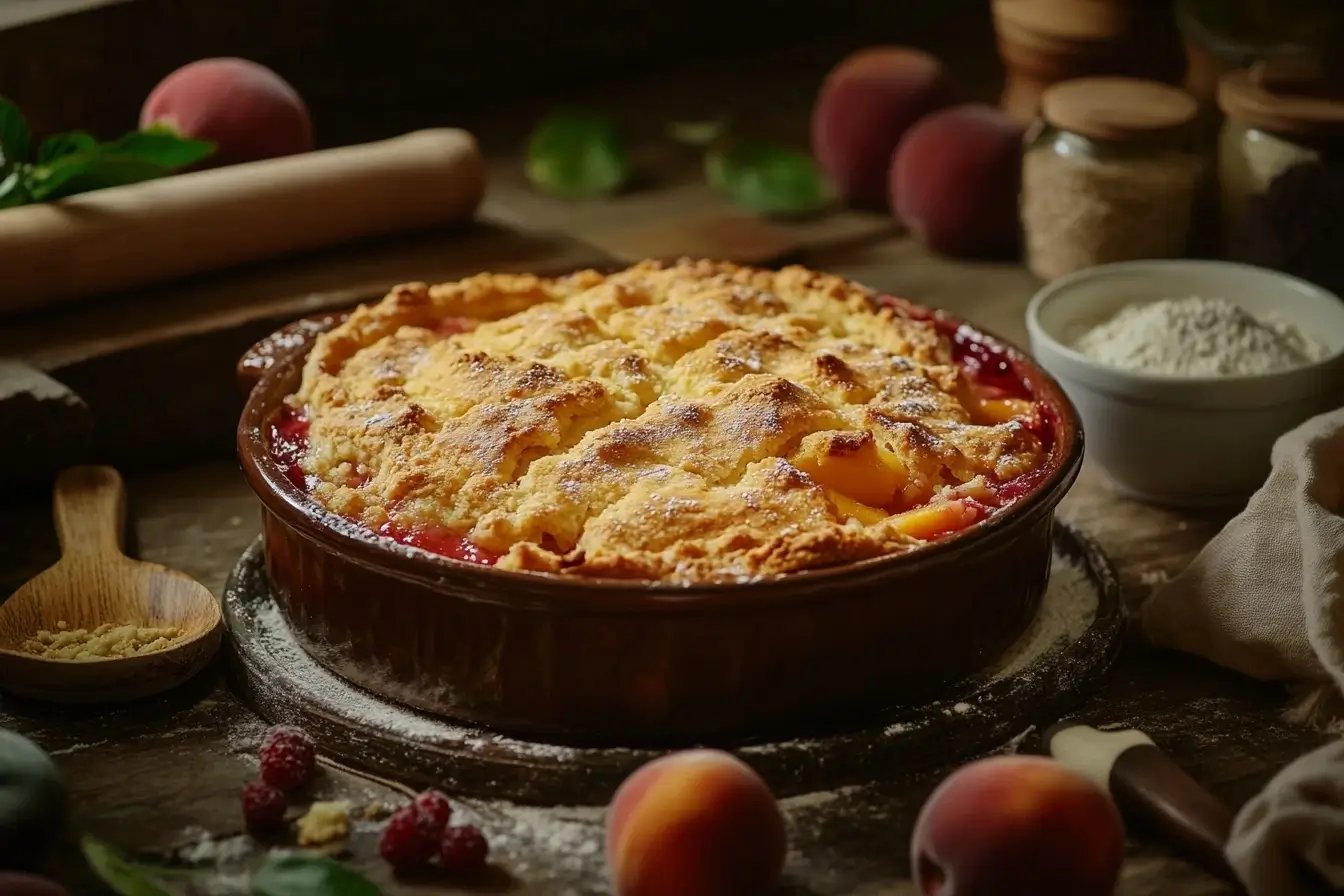When it comes to making cobbler, one common question often arises: Is cobbler supposed to be moist? This dessert, with its luscious fruit filling and comforting topping, walks a fine line between juicy perfection and being overly runny or too dry. Whether you’re a seasoned baker or trying cobbler for the first time, understanding the ideal texture is key. From choosing the right ingredients to mastering baking techniques, this guide will cover everything you need to know. Let’s dive in and see how to achieve cobbler bliss!
Introduction to Cobbler
Cobbler is a classic dessert that has charmed palates for generations. With its origins rooted in simplicity, it brings together a fruit filling and a biscuit-like topping, baked to create a harmonious marriage of textures. But what makes a cobbler distinct from similar desserts like crisps or crumbles? It’s all in the topping and how the fruit is prepared.
Definition and Origin of Cobbler
A cobbler isn’t just any fruit dessert. Traditionally, it features a baked fruit filling topped with a dough that’s either dropped or spread over the fruit. It is believed to have originated in the British colonies in America as a substitute for pies. Early settlers lacked ovens and pie crust ingredients, so they improvised with what they had.
Popular Variations Across Regions
Interestingly, cobbler takes on slightly different forms depending on where you are. In the South, you’ll find peach cobblers with a buttery crust, while in the Midwest, berry cobblers dominate. No matter the variation, the goal is to achieve a balance of juicy fruit and tender topping. For more detailed tips, recipes, and frequently asked questions, check out this guide on How to Make the Perfect Chocolate Cobbler.
Texture Expectations in a Cobbler
To answer the question, Is cobbler supposed to be moist?—yes, but there’s a nuance. The fruit filling should be juicy, but not runny. Similarly, the topping should be slightly crisp on the outside yet soft and tender underneath. Striking the right balance is essential for a satisfying cobbler.
Ideal Moistness Level
Moistness in a cobbler comes down to the fruit juices released during baking. Too much liquid can make the dish soggy, while too little can leave it dry and unappetizing. The key is achieving a luscious filling that thickens slightly as it bakes, complemented by a topping that absorbs just enough of the juices.
Comparison with Other Desserts
What sets cobbler apart from desserts like crisps or crumbles is its topping. While crisps use oats and crumbles rely on streusel-like mixtures, cobblers have a distinct biscuit or batter topping. This difference influences both the texture and moistness of the final dish.
Factors Influencing Cobbler Moistness
Cobbler’s moistness is influenced by several factors, from the type of fruit you choose to how long you bake it. Each element contributes to the texture and consistency of this beloved dessert. Understanding these aspects can help you create a cobbler that’s neither too soggy nor overly dry.
Type and Ripeness of Fruit Used
The fruit you select plays a starring role in determining the moisture level of your cobbler. Juicier fruits, like peaches, plums, and berries, naturally release more liquid during baking. This makes them ideal for cobblers when balanced with the right amount of thickener. On the other hand, firmer fruits, such as apples, tend to release less juice, resulting in a drier filling unless supplemented with extra liquid or sugar.
Ripeness is another critical factor. Overripe fruits contain higher water content, which can lead to a runnier filling. For instance, fully ripe peaches can create a lush, moist cobbler but may require additional steps to prevent excess liquid. Striking the right balance between ripe and firm fruit is key.
Sugar Content and Its Effects
Sugar does more than just sweeten a cobbler—it interacts with fruit juices to influence the dish’s texture. When sugar is added to the fruit, it draws out moisture through osmosis. While this is essential for creating a juicy filling, adding too much sugar can result in an overly wet cobbler.
The type of sugar matters too. Brown sugar adds moisture and depth of flavor, whereas white sugar keeps the filling lighter. Balancing sweetness without drowning the dish in syrupy liquid is a skill every cobbler enthusiast should master.
Baking Time and Temperature
Baking is where everything comes together—or falls apart. Too short a baking time can leave the fruit undercooked and the topping soggy, while too long can dry out the filling and harden the crust. Baking at the right temperature, usually around 375°F (190°C), allows the fruit to release juices and the topping to bake evenly. Keeping a close eye on the cobbler during the last few minutes can make all the difference.
Thickness of the Topping
The topping’s thickness determines how much moisture it absorbs from the filling. A thick biscuit topping tends to soak up more juices, while a thinner batter topping might let some moisture seep through. Adjusting the topping’s density based on the fruit’s juiciness is a handy trick to perfect your cobbler. For instance, with juicier fruits, a slightly thicker topping can prevent the filling from becoming overly watery.
Selecting the Right Ingredients
Choosing the right ingredients is the first step toward a cobbler with perfect texture and moisture. From selecting juicy fruits to balancing flavors, every choice impacts the final result.
Choosing Fruits with Appropriate Juiciness
Not all fruits are created equal when it comes to cobblers. Juicy fruits like peaches, blackberries, and cherries are classic choices because they produce a luscious filling when baked. However, too much juice can turn your cobbler into a watery mess. To manage this, pair juicier fruits with less watery counterparts like apples or pears for balance.
Frozen fruits can also work well but often release extra water when thawed. If using them, thaw completely and drain excess liquid to avoid an overly wet cobbler.
Balancing Sweeteners and Acidity
Sweeteners and acidity bring out the natural flavors of the fruit while controlling moisture. Too much sugar can overpower the fruit and make the filling too runny. A sprinkle of lemon juice or a pinch of zest adds acidity, cutting through the sweetness and enhancing the overall flavor profile.
For a deeper dive into the health benefits and risks of sugar consumption, visit Healthline for expert guidance.
If your fruit is naturally tart, like rhubarb or cranberries, you’ll need to adjust the sugar-to-acid ratio carefully. For sweet fruits such as peaches or strawberries, use a lighter hand with sugar to preserve their natural juiciness without creating a syrupy filling.
Preparing the Fruit Filling for the Perfect Cobbler Recipe
The way you prepare the fruit filling has a huge impact on the texture and consistency of your cobbler. With a little extra care, you can ensure your dessert achieves the ideal cobbler moisture level while maintaining a balanced, flavorful filling.

Techniques to Manage Fruit Juices for a Moist Cobbler Dessert
Managing fruit juices is a balancing act that ensures your cobbler is moist but not overly runny. For naturally juicy fruits like peaches or berries, sprinkle the fruit with sugar and let it sit for about 20 minutes. This process, called maceration, draws out excess liquid, which you can drain off to prevent a watery filling.
Another effective method is briefly cooking the fruit on the stovetop before assembling the cobbler. This helps evaporate some moisture while softening the fruit and concentrating its natural flavors.
When layering the fruit in the baking dish, ensure even distribution. Uneven layers can cause pooling juices, leading to an inconsistent texture. By spreading the fruit uniformly, the topping can bake evenly without soaking up too much liquid.
Using Thickeners Like Cornstarch to Fix Runny Cobbler
Thickeners are essential for stabilizing the juices in a moist cobbler dessert. Cornstarch is a popular choice because it creates a smooth, glossy finish. Mix 1–2 tablespoons of cornstarch with sugar before tossing it with the fruit to ensure even distribution.
For fruits that release a lot of liquid, such as cherries or blueberries, quick-cooking tapioca pearls or all-purpose flour can also be effective alternatives. Tapioca pearls provide a translucent, firm texture, while flour offers a more opaque consistency. The amount of thickener needed depends on the fruit’s juiciness—juicy fruits like peaches may require slightly more than firmer ones like apples.
Thickener Quick Guide:
| Thickener | Best Use Case | Tips for Use |
|---|---|---|
| Cornstarch | Juicy fruits (peaches, berries) | Mix with sugar before adding to fruit |
| All-Purpose Flour | Firmer fruits (apples, pears) | Use sparingly; too much can create a pasty texture |
| Tapioca Pearls | Highly juicy fruits (cherries, plums) | Quick-cooking tapioca works best for consistency |
By choosing the right technique and thickener, you’ll create a fruit filling that perfectly complements the topping and maintains the classic cobbler texture. This step is crucial for achieving a dessert that’s rich, satisfying, and balanced.
Creating the Topping
The topping of a cobbler is what sets it apart from other desserts. Whether you prefer a biscuit topping or a batter-based one, each option brings its own unique texture and flavor to the dish. Let’s explore these choices and how to perfect them.
Biscuit vs. Batter Toppings
Choosing between a biscuit and batter topping comes down to personal preference and the type of cobbler you’re making. A biscuit topping is traditional, offering a slightly crunchy crust with a tender inside. It’s perfect for absorbing just the right amount of fruit juices without becoming soggy.
Batter toppings, on the other hand, are lighter and spread more easily over the fruit. As they bake, they form a golden crust that’s softer and more uniform. This style is often used in Southern cobblers and pairs beautifully with juicy fruits like peaches or berries.
Both options can be customized by adding spices like cinnamon or nutmeg, or even incorporating a bit of citrus zest for extra flavor.
Achieving the Desired Texture
The texture of your topping depends on how you prepare and handle the dough or batter. For biscuit toppings, avoid overmixing the dough, as this can make it dense and chewy. Aim for a consistency that’s just combined, leaving small pockets of butter to create flakiness during baking.
For batter toppings, use a light hand when spreading over the fruit to avoid pushing out too much juice. The batter should be thin enough to spread easily but thick enough to hold its shape as it bakes.
Baking Techniques for Optimal Moistness
The baking process is where your cobbler comes to life. Getting the oven temperature and baking time just right ensures the perfect combination of a moist filling and a well-cooked topping.

Importance of Oven Temperature
Oven temperature plays a pivotal role in achieving a moist cobbler. Baking at around 375°F (190°C) allows the fruit filling to bubble gently and release its natural juices without becoming overly watery. This temperature also helps the topping cook evenly, forming a golden crust that complements the juicy filling beneath.
Too low a temperature may result in undercooked fruit and a soggy topping, while too high can dry out the cobbler or burn the crust before the fruit is fully cooked. Using an oven thermometer can help ensure your oven’s temperature is accurate.
Determining the Right Baking Duration
The ideal baking time for cobbler varies depending on the type of topping and the juiciness of the fruit. Typically, 35 to 45 minutes is sufficient. Start checking the cobbler around the 30-minute mark. Look for bubbling fruit around the edges and a topping that’s golden brown.
If the topping browns too quickly, you can tent the cobbler with foil to prevent burning while the filling finishes cooking. Allow the cobbler to cool slightly before serving—this helps the juices thicken and prevents a runny mess when you scoop it out.
Serving Suggestions for the Perfect Cobbler Recipe
Pairing Moist Cobbler Desserts with Ice Cream or Whipped Cream
Cobbler and ice cream are a match made in dessert heaven. A warm slice of moist cobbler dessert served with a scoop of vanilla ice cream creates a delightful contrast of temperatures and textures. The creaminess of the ice cream melts into the cobbler texture, complementing its sweet, juicy filling and buttery topping.
Alternatively, a dollop of freshly whipped cream can add a light, airy touch. For an extra hint of flavor, try topping the whipped cream with a sprinkle of cinnamon or a drizzle of honey. It’s the ideal finish for a perfect cobbler recipe that satisfies every sweet tooth.

Serving Cobbler at the Ideal Temperature for the Best Texture
Cobbler is best served warm, shortly after it’s baked. Allow it to cool for about 20 minutes to let the fruit filling settle and thicken slightly. If served straight from the oven, the filling might be too runny, and the heat could overpower the flavors.
On the other hand, cobbler texture can also be enjoyed at room temperature or even chilled, depending on your preference. Warm cobbler highlights the buttery crust and juicy filling, while chilled cobbler offers a refreshing contrast, especially on a hot day. Whatever temperature you choose, it’s a dessert that delights in every bite.
Storing Leftovers Without Compromising Cobbler Moisture Levels
Preventing Sogginess in Stored Cobbler
Storing leftover cobbler without compromising its moisture level or texture can be tricky. To avoid sogginess, let the cobbler cool completely before covering it. Store it in an airtight container or cover the baking dish tightly with plastic wrap. For best results, keep it in the refrigerator, especially if it contains dairy or perishable ingredients.
If possible, store the topping and fruit filling separately. This ensures the topping retains its crispness, and the fruit doesn’t soak into it over time, helping maintain the cobbler moisture level.
Reheating Cobbler to Fix Sogginess and Maintain Texture
To reheat cobbler and preserve its perfect texture, use the oven instead of a microwave. Preheat the oven to 350°F (175°C) and place the cobbler in an oven-safe dish. Cover it with foil to prevent the topping from drying out and bake for 10–15 minutes, or until warmed through.
For individual portions, a toaster oven is also a great choice to avoid making the topping soft. If you’re in a rush, the microwave is an option, but it may lead to sogginess. To fix a runny cobbler, a quick broil at the end of reheating can restore some crispness to the topping while thickening the filling.
Overcoming Common Cobbler Pitfalls for a Perfect Cobbler Recipe
Even the most seasoned bakers can run into challenges when making cobbler. Whether it’s too moist, too dry, or unevenly baked, these common pitfalls can be addressed with a few simple adjustments, ensuring your cobbler achieves the ideal cobbler moisture level and texture.
Avoiding Excessive Moistness in Cobbler
A cobbler that’s too moist can quickly turn into a soggy mess. To answer the common question, Is cobbler supposed to be moist?—yes, but only within reason. To maintain the proper cobbler moisture level, start by selecting fruits that balance juiciness without being overly watery. For example, draining excess liquid from juicy fruits like peaches or berries is essential to prevent the filling from becoming overly runny and losing its structure.
Adding a thickener, such as cornstarch, tapioca, or flour, is a reliable way to stabilize the filling and address concerns about is cobbler supposed to be moist. This step ensures that the juices released during baking create a cohesive, glossy texture rather than pooling at the bottom and ruining the dessert.
Keep an eye on sugar content, as too much sugar can draw out additional liquid from the fruit, especially when combined with heat. If excessive bubbling occurs during baking, it’s a sign you may have over-sweetened the filling or underused a thickener. Adjust these elements in your recipe to achieve the perfect moist cobbler dessert. Balancing these factors ensures the answer to Is cobbler supposed to be moist remains a delightful yes—without the mess!
Preventing a Dry Cobbler
A dry cobbler often results from insufficient fruit juices or an overbaked topping. To prevent dryness and achieve the ideal cobbler texture, start by ensuring your fruit is ripe and naturally juicy. If you’re working with drier fruits like apples or pears, consider adding a splash of juice, water, or even a fruit puree to the filling for added moisture.
For the topping, avoid overbaking. A topping that’s left in the oven too long can harden and lose its tenderness. Bake just until the fruit filling bubbles around the edges and the topping turns a light golden brown. Watch the oven closely during the last few minutes to prevent overcooking.
Ensuring Even Baking for the Best Cobbler Texture
Uneven baking can lead to undercooked fruit or a soggy center, detracting from your cobbler’s appeal. To ensure consistent results, spread the fruit filling evenly across the baking dish. This not only allows the juices to distribute uniformly but also helps the topping bake evenly.
Distribute the topping layer evenly as well, avoiding overly thick or thin spots. Use a preheated oven for consistent heat, and rotate the baking dish halfway through cooking. This ensures even exposure to heat and helps achieve the perfect cobbler texture.
By mastering these adjustments, you’ll avoid the common pitfalls and enjoy a perfectly balanced cobbler every time!
Expert Tips for Perfecting Your Cobbler Recipe
Perfecting cobbler comes down to small details that make a big difference. These expert tips will help you consistently achieve the ideal cobbler moisture level, flavor, and texture while addressing the question, Is cobbler supposed to be moist?
Balancing Fruit and Topping Ratios for the Best Cobbler Texture
The ratio of fruit to topping is crucial for creating a well-balanced moist cobbler dessert. But wait—is cobbler supposed to be moist if you use too much fruit? The answer is yes, but it’s all about balance. Too much fruit can overwhelm the topping, making the cobbler excessively wet. Conversely, too little fruit might result in a dry, unsatisfying dessert, leaving you wondering if the moisture is missing altogether.
For the best results, aim for a 2:1 ratio of fruit to topping. This thoughtful ratio ensures that the fruit remains the centerpiece of the dish, while the topping adds just enough structure and flavor to enhance it. The right balance is key to addressing, Is cobbler supposed to be moist?
When assembling your cobbler, spread the fruit evenly across the baking dish. Layer the topping in a way that doesn’t completely cover the fruit. Doing so allows some juices to bubble up, creating the perfect visual and textural contrast. And yes, bubbling juices are a surefire sign that the answer to Is cobbler supposed to be moist is absolutely yes.
By maintaining these ratios and preparation techniques, you’ll always have a cobbler that’s just right—deliciously moist but never soggy. After all, is cobbler supposed to be moist? With the right fruit and topping ratios, it most certainly should be!
Adjusting Recipes for Different Fruits to Avoid Runny Cobbler
Fruits behave differently when baked, and understanding their characteristics can help you create a perfect cobbler recipe.
- Juicy Fruits: Peaches, berries, and cherries tend to release a lot of liquid during baking. To prevent a runny cobbler fix, mix these fruits with a thickener such as cornstarch or tapioca. Start with about 1–2 tablespoons per cup of fruit.
- Firmer Fruits: Apples and pears are less juicy and can remain firm if not prepared correctly. Pre-cooking these fruits by sautéing or baking them for a few minutes helps release their juices and softens their texture, ensuring a cohesive cobbler filling.
- Mixed Fruits: Combining different fruits, like berries with apples, can add variety in texture and flavor. Adjust the thickener and sweetness accordingly to balance the juiciness of the mix.
Fruit Preparation Tips Table
| Fruit Type | Juiciness Level | Preparation Tips | Thickener Needed |
|---|---|---|---|
| Peaches | High | Peel and slice; mix with cornstarch to thicken juices | 1–2 tbsp per cup of fruit |
| Berries | High | Rinse and drain; add cornstarch or flour | 1 tbsp per cup of fruit |
| Apples | Low to Medium | Pre-cook slices; add sugar or juice for moisture | Minimal thickener required |
| Pears | Medium | Peel and slice; use sugar for sweetness if needed | Optional, 1 tbsp if juicy |
| Cherries | High | Pit and mix with sugar; use cornstarch | 1–2 tbsp per cup of fruit |
By mastering these ratios and adjustments, you’ll enjoy a cobbler with the perfect balance of juicy filling and tender topping every single time. From fruit selection to precise preparation, these tips will help your cobbler become a household favorite!
Frequently Asked Questions
How do I fix a runny cobbler?
If your cobbler turns out runny, it likely means there was too much liquid in the filling or not enough thickener. You can try baking it for an additional 10–15 minutes to evaporate some excess moisture. If that doesn’t work, let the cobbler sit for 20–30 minutes after baking—this allows the filling to set as it cools. In the future, add a thickener like cornstarch or tapioca to stabilize the juices before baking.
How to make a chocolate cobbler?
Chocolate cobbler is a decadent dessert made with a fudgy, brownie-like base and a molten chocolate sauce layer. It’s typically made by layering a batter of flour, sugar, cocoa powder, and milk over melted butter, then sprinkling dry cocoa and sugar on top before adding hot water. The magic happens in the oven as the layers transform into a gooey, rich dessert. Serve warm with vanilla ice cream for the ultimate treat!
For a detailed step-by-step recipe guide, visit How to Make a Chocolate Cobbler.
What is chocolate cobbler?
Chocolate cobbler is a twist on the traditional fruit cobbler, replacing fruit with a rich chocolate filling. The result is a dessert that’s part brownie, part lava cake, with a soft crust on top and a gooey chocolate sauce underneath. It’s a perfect choice for chocolate lovers and makes a standout addition to any dessert table.To dive deeper into its history and unique characteristics, visit What Is Chocolate Cobbler? A Delicious Southern Dessert Explained.
How to BBQ right chocolate cobbler?
Chocolate cobbler can be adapted for barbecuing by preparing it in a cast-iron skillet. Follow the same recipe as you would for baking, then cook it over indirect heat on a covered grill. Maintain a consistent temperature of around 350°F (175°C) and rotate the skillet occasionally for even cooking. The result is a smoky, gooey dessert perfect for outdoor gatherings.
Do you refrigerate chocolate cobbler?
Yes, chocolate cobbler should be refrigerated if not consumed within a few hours. Allow it to cool completely, then cover it tightly before placing it in the refrigerator. When ready to serve, reheat individual portions in the microwave or oven to restore its warm, gooey texture.
How to make chocolate pecan cobbler?
Chocolate pecan cobbler combines the rich flavor of chocolate with the nutty crunch of pecans. To make it, prepare a chocolate cobbler base and sprinkle chopped pecans over the batter before baking. For an extra layer of indulgence, drizzle caramel sauce over the cobbler after baking.
What’s the difference between a peach cobbler and a crumble?
The primary difference lies in the topping. A peach cobbler typically has a biscuit or batter topping, which forms a soft, slightly crispy crust. A crumble, on the other hand, uses a streusel-like topping made from butter, flour, sugar, and sometimes oats, creating a crumbly texture. Both are delicious but offer distinct textures and flavors.For a detailed explanation of all key differences, visit Peach Cobbler vs Crumble: Key Differences Explained.
What is cobbler crust made of?
Cobbler crust can be made from a variety of ingredients depending on the recipe. Traditional biscuit toppings use flour, sugar, butter, and milk or buttermilk to create a dough. Batter toppings often combine flour, sugar, baking powder, and milk to form a pourable mixture. Both options create a satisfying contrast to the juicy filling.
Why is my cobbler so runny?
A runny cobbler usually results from too much liquid in the filling or insufficient thickener. Juicy fruits release water during baking, which can lead to a watery filling if not properly managed. Adding a thickener like cornstarch, flour, or tapioca and allowing the cobbler to cool before serving can prevent this issue.
Conclusion
Cobbler is a timeless dessert that brings together the comforting sweetness of fruit and the satisfying texture of a biscuit or batter topping. The key to mastering this dish lies in understanding its balance—Is cobbler supposed to be moist? Absolutely, but finding just the right amount of moisture is crucial for perfection.
When preparing your cobbler, always consider the moisture levels of the fruit, the thickness of the topping, and the impact of baking techniques. These elements ensure your cobbler strikes the right balance. After all, is cobbler supposed to be moist if it’s baked with precision? Yes, and achieving the correct texture transforms this classic dessert into a showstopper.
Whether you’re experimenting with traditional peach cobbler, venturing into a decadent chocolate cobbler, or customizing recipes with a mix of fruits, always remember the key question: Is cobbler supposed to be moist? This focus on moisture and balance will guide you to dessert success.
As you follow the tips in this guide, every cobbler you bake can be a masterpiece. With thoughtful serving suggestions and effective storage techniques, you’ll keep your cobbler fresh and satisfying, no matter the occasion.
So, roll up your sleeves, grab your ingredients, and get baking. After all, is cobbler supposed to be moist? Without a doubt, and that’s exactly what makes it so irresistible. There’s nothing quite like the aroma of a freshly made cobbler wafting through your kitchen—warm, inviting, and perfectly moist. Enjoy!

